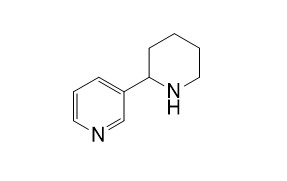(+/-)-Anabasine
(+/-)-Anabasine and (−)-cytisine exhibit partial agonist on nicotinic acetylcholine receptor (nAChR).
Inquire / Order:
manager@chemfaces.com
Technical Inquiries:
service@chemfaces.com
Tel:
+86-27-84237783
Fax:
+86-27-84254680
Address:
1 Building, No. 83, CheCheng Rd., Wuhan Economic and Technological Development Zone, Wuhan, Hubei 430056, PRC
Providing storage is as stated on the product vial and the vial is kept tightly sealed, the product can be stored for up to
24 months(2-8C).
Wherever possible, you should prepare and use solutions on the same day. However, if you need to make up stock solutions in advance, we recommend that you store the solution as aliquots in tightly sealed vials at -20C. Generally, these will be useable for up to two weeks. Before use, and prior to opening the vial we recommend that you allow your product to equilibrate to room temperature for at least 1 hour.
Need more advice on solubility, usage and handling? Please email to: service@chemfaces.com
The packaging of the product may have turned upside down during transportation, resulting in the natural compounds adhering to the neck or cap of the vial. take the vial out of its packaging and gently shake to let the compounds fall to the bottom of the vial. for liquid products, centrifuge at 200-500 RPM to gather the liquid at the bottom of the vial. try to avoid loss or contamination during handling.
Front Plant Sci.2020, 10:1705
bioRxiv - Biochemistry2023, 541790.
Food Chem.2020, 332:127412
Korean J. Agricultural Science2024, 51(3).
Plant Physiol Biochem.2023, 202:107913.
Biomolecules.2022, 12(12):1754.
Heliyon.2024, 10(7):e28364.
Molecules.2022, 27(22):7887.
Foods.2024, 13(11):1739.
Anal Bioanal Chem.2016, 408(1):177-90.
Related and Featured Products
Brain Research, 1994,643(1-2):1-9.
Clozapine attenuates the discriminative stimulus properties of (−)-nicotine.[Reference:
WebLink]
METHODS AND RESULTS:
Rats were trained to discriminate 1.9 μmol/kg (−)-nicotine (0.3 mg/kg) from saline in a standard two-bar operant conditioning paradigm with food reinforcement. The effect of neuronal nicotinic acetylcholine receptor (nAChR) agonists and antagonists were verified, and the participation of dopaminergic receptors subtypes in the expression of the (−)-nicotine cue was investigated with cis-flupentixol (D1-D2 antagonist), haloperidol (D2 antagonist) and clozapine (D4 antagonist). The stereoselectivity of the behavioral response was indicated by the 10-fold less sensitivity to (+)-nicotine in (−)-nicotine-trained rats. (+/-)-Anabasine and (−)-cytisine exhibited partial agonist profiles at the 1.9 μmol/kg dose while (−)-lobeline was devoid of any effect in doses up to 19 μmol/kg. (−)-Lobeline did not show antagonist properties in this paradigm. The nicotinic channel blockers mecamylamine, chlorisondamine and hexamethonium were inactive on their own but mecamylamine and chlorisondamine were able to block the effect of (−)-nicotine. Clozapine attenuated the (−)-nicotine cue while cis-flupentixol and haloperidol were ineffective. Similar doses of cis-flupentixol significantly blocked the locomotr stimulant effect of (−)-nicotine in rats indicating that blockade of dopaminergic receptors was achieved at the doses used in the drug discrimination studies.
CONCLUSIONS:
These data suggest that the discriminative stimulus properties of (−)-nicotine are mediated through neuronal nAChRs and involves the activation of dopaminergic receptors of the D4 subtype.



